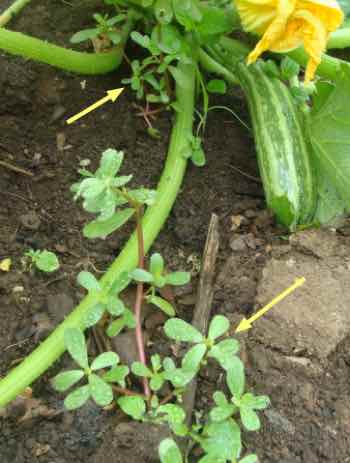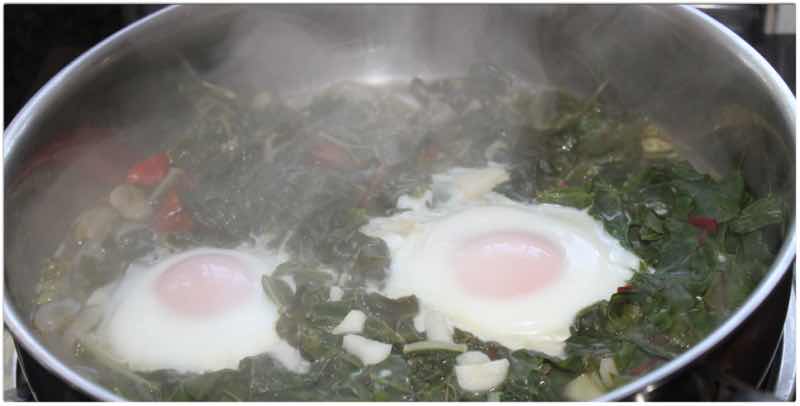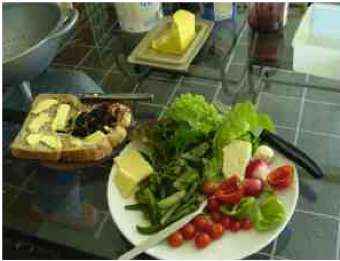- Bernard Preston homepage
- Greens
- Purslane Plant
Purslane plant
Purslane plant, also known as Portulaca oleracea is a highly desirable salad ingredient in the Mediterranean, rich in omega-3; and vitamins A, E and C. These are two of the four nutrients that, if they are deficient in the diet are strongly associated with frailty syndrome.
Below you can see two young plants with their characteristic reddish stems in the zucchini patch.

This page was last updated by Dr Bernard Preston on 9th April, 2024.
Portulaca oleracea
Okay so I'll confess it up front; for many years I thought portulaca oleracea, also known as the purslane plant was a weed. I dug it out ruthlessly from our vegetable garden, fortunately dumping it on the compost-heaps where it seemed to flourish and seeded itself.
The moral of the story is don't throw weed seeds into your compost pile unless it is one of those that gets incredibly hot. I will be getting to that one of these days; they need bacteria like in chicken-litter.
After 6 years of weeding out purslane plants we have more than ever in our garden.
It's a succulent with thick fleshly-leaves and stems that flourishes in the summer, flowers and seeds; and dies back in the winter. In the spring, up it pops again, much to my chagrin in former years.
Prejudice is being down on something you're not up on.
I was not up on portulaca oleracea. It's a smooth, reddish plant that grows along the ground with what is described as prostrate stems. It has tiny yellow-flowers that form pods full of seeds.
Purslane plant
Helen first introduced me to purslane plant in a salad after listening to our nurseryman; I was skeptical but soon discovered that it has a not unpleasant acidic-flavour. Call it sour if you prefer. It is also a bit salty.
 The perfect breakfast; low in carbs, high in important nutrients.
The perfect breakfast; low in carbs, high in important nutrients.She then dropped bits, unbeknown to me, into our Eggs Florentine; whenever we are short of spinach, we use other organic green food to augment it. I complimented her on the breakfast, and out came the whole-truth.
Raw in a Greek salad, or cooked in an Italian breakfast, portulaca oleracea is a wonderful nutritious herb, or weed if you prefer, with a powerful array of vitamins and especially rich in omega-3; not only ALA which is not uncommon in plants, but also EPA and DHA[4] which are found mainly in fish oil.
Together with the vitamins C and E, this makes the purslane plant strongly anti-inflammatory.
So we now add purslane to our stir fries, raw in a variety of salads and often tossed into any dish where we would normally have used spinach or Swiss chard; or in addition to them, to give a little bulk.
It will thicken up a soup too by the way; that's much better than adding flour or cornmeal.
Incidentally adding homemade pesto or hummus to any green salad will turn it into a gem; they are so easy to make though you will need to find slightly unusual ingredients like pine nuts and a sesame paste called tahini. Your Greek or Turkish shops will help you.
I particularly enjoy portulaca oleracea, its botanical name, in a Greek salad with olives and feta cheese.
Organic green food

Organic green food is the basis of almost every decent salad; generally ours will consist of several different lettuce varieties, a few young shoots of kale and baby spinach; and spring-onion tops. Adding a few leaves and stalks of purslane plant simply promotes a slightly different sour taste that we love.
Adding a few herbs like parsley, cilantro and sweet basil, together with olive oil and freshly-squeezed lemon juice will turn it into a treat. It's all about aiming for those elusive ten coloured foods every day.
Then add a few more colours like tomato, radish and a yellow pepper; and an avocado. Now you are home and dry.
This is not just rhetoric about coloured foods; there's strong research following fruitcakes like me over twenty years that indicates that those who enjoy at least eight to ten have a 35 percent lower all-cause of death. That is massive.
There is better eyesight from lutein and zeaxanthin so fewer falls and motor accidents, for example; zero constipation implies little chance of colo-rectal cancer. All the antioxidant minerals mean no problems with homocysteine; we could go on.
Perhaps the greatest benefit of portulaca oleracea is its rich concentration of omega-3; mainly the fatty acid ALA but also the EPA that is found predominantly in seafood like salmon, mackerel and krill.
You can read about all the different fatty acids at our anti-inflammatory page.
According to that fountain of all knowledge, Wikipedia, in fact it is the richest source of omega-3 of all leafy green plants; that would not include those from the sea.
Then there are the wide variety of vitamins, including A, B and C giving purslane its strong anti-tumorgenic status; E and carotenoids too.
As an aside, there is so much news about the hugely expensive forms of tumour treatment but so little about prevention.
I decided some years ago, having a lot of malignant disease in my family, that I would do my damnedest not to get the big C.
So prevention has become the focus of our attention; one of the wonderful benefits that greenies enjoy is a life without medication. Helen and I take virtually no drugs.
Just recently my optician expressed astonishment that there was no sign of cataracts or macular degeneration in my eyes; the urologist surprise that my PSA was only 0.9. That is quite remarkable, said he, at 68.
And now 7 years later all is still well in both departments.
That incidentally is what is known as an anecdote, and has no scientific value. You are at liberty to ignore it, but for me it is part of the bigger picture. Something of course will get us all in the end.
Omega-3
Omega 3 consists of three fatty acids that have a strongly anti-inflammatory effect in the body; all are richly found in purslane plant.
As a general rule we consume far too much omega-6 and not enough of the 3.
Purslane is the richest plant source of omega-3 in your garden. It's one of the reasons that free-range fowls lay eggs that have three times as much of these very important fatty acids; that is vitally important to your DC as the pain in your joints and muscles may not in fact be caused by subluxations.
Researchers have found that those living with heart failure too have a 39% reduced chance of dying or being hospitalised by increasing the levels of plant-based omega 3[5]; purslane plant, freshly ground flax seed and walnuts are common sources.
True free range eggs are hard to come by but if you do your homework, you can find a good farm where the hens are able to feed on omega-3 rich plants.
In the United Kingdom they are known as "proper eggs;" free-range and fertile.
Is purslane better raw or cooked
As with most salads there are benefits from eating purslane both raw and cooked. Enjoy it in a salad or simply drop a few leaves into any green that you are cooking.
We will often drop a few leaves into our Eggs Florentine breakfast for example when cooking the spinach.
How much purslane should I eat in a day?
How much purslane you should eat in a day is a controversial subject. Previously because of its oxalate content it was recommended that you limit the amount to a tablespoon or two.
However new research has found that the amount of oxalate- rich foods we eat has no influence on whether we get kidney stones or not; it is the microbiome that controls that. So don't fuss; not overboard but just enjoy your purslane plant.
- Anti-inflammatory omega 3.
- Flax seed nutrition information; another excellent source of omega-3. Web: https://tinyurl.com/4jv8cvtk
- Frailty syndrome
- Purslane Weed (Portulaca oleracea): A Prospective Plant Source of Nutrition, Omega-3 Fatty Acid, and Antioxidant Attributes
- A diet rich in plant-based omega-3 is associated with better outcomes in heart failure patients
When browsing use right click and Open Link in New Tab, or you may get a bad gateway signal.
Newsletter
Our newsletter is entitled "create a cyan zone" at your home, preserving both yourself and Mother Earth for future generations; and your family too, of course. We promise not to spam you with daily emails promoting various products. You may get an occasional nudge to buy one of my books.
Here are the back issues.
- Investing in long-term health
- Diseases from plastic exposure
- Intensive lifestyle management for obesity has limited value
- A world largely devoid of Parkinson's Disease
- The impact of friendly bacteria in the tum on the prevention of cancer
- There's a hole in the bucket
- Everyone is talking about weight loss drugs
- Pull the sweet tooth
- If you suffer from heartburn plant a susu
- Refined maize meal and stunting
- Should agriculture and industry get priority for water and electricity?
- Nature is calling
- Mill your own flour
- Bake your own sourdough bread
- Microplastics from our water
- Alternative types of water storage
- Wear your clothes out
- Comfort foods
- Create a bee-friendly environment
- Go to bed slightly hungry
- Keep bees
- Blue zone folk are religious
- Reduce plastic waste
- Family is important
- What can go in compost?
- Grow broad beans for longevity
- Harvest and store sunshine
- Blue zone exercise
- Harvest and store your rainwater
- Create a cyan zone at your home
Bernard Preston
Bernard Preston is a semi-retired DC with a passion for living a simple, zestful life without medication; that means plenty of omega 3 foods like purslane plant.
That means being focused on the prevention of disease. Let your food me your medicine, said Thomas Edison. Is that totally impractical and absurd?
No, it's not. It does not mean that in a crisis we will not take medication; but we are very conscious of the fact that prescription-drugs are the third greatest cause of death, after heart disease and cancer. Just type "iatrogenic disease" into Wikipedia and you will be astonished.
Bernard Preston is the hyperactive sort; he flies gliders, keeps bees and has built a solar farm on his roof. He is busy with his seventh novel. If you've appreciated this site, you can purchase them to support him; on your Kindle or tablet they are dirt cheap.
A Family Affair
A Family Affair is a trilogy of intrigue and deception by Bernard Preston.
~ 99c each.



Did you find this page interesting? How about forwarding it to a friend, or book and food junkie? Better still, a social mead tick would help.
- Bernard Preston homepage
- Greens
- Purslane Plant
Address:
56 Groenekloof Rd,
Hilton, KZN
South Africa
Website:
https://www.bernard-preston.com